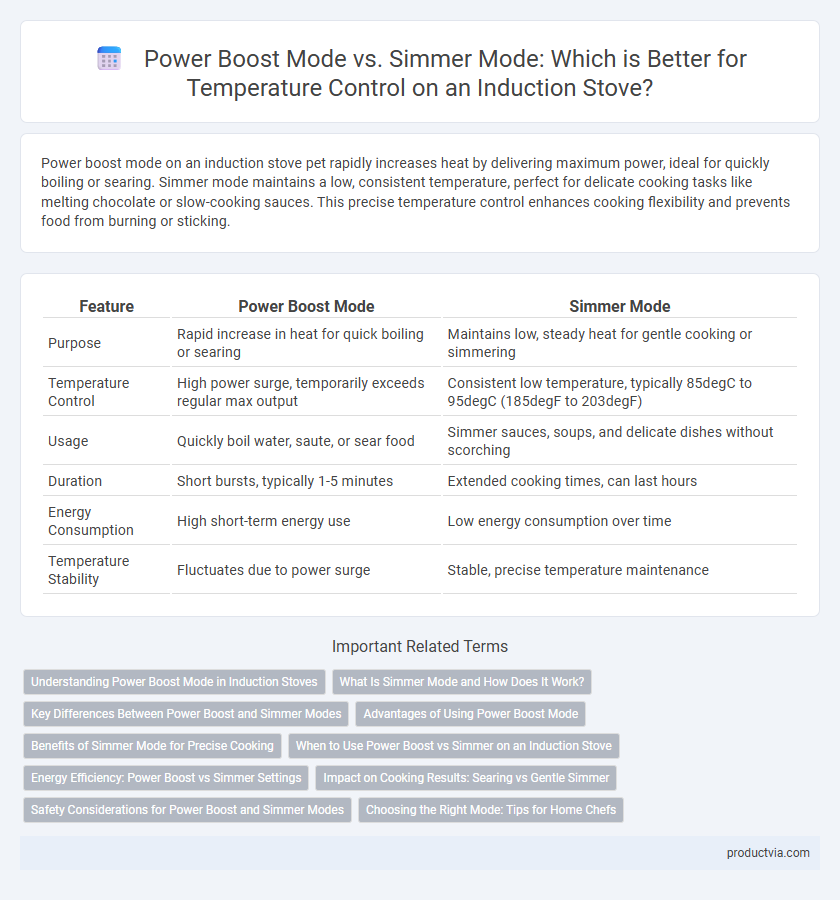Power boost mode on an induction stove pet rapidly increases heat by delivering maximum power, ideal for quickly boiling or searing. Simmer mode maintains a low, consistent temperature, perfect for delicate cooking tasks like melting chocolate or slow-cooking sauces. This precise temperature control enhances cooking flexibility and prevents food from burning or sticking.
Table of Comparison
| Feature | Power Boost Mode | Simmer Mode |
|---|---|---|
| Purpose | Rapid increase in heat for quick boiling or searing | Maintains low, steady heat for gentle cooking or simmering |
| Temperature Control | High power surge, temporarily exceeds regular max output | Consistent low temperature, typically 85degC to 95degC (185degF to 203degF) |
| Usage | Quickly boil water, saute, or sear food | Simmer sauces, soups, and delicate dishes without scorching |
| Duration | Short bursts, typically 1-5 minutes | Extended cooking times, can last hours |
| Energy Consumption | High short-term energy use | Low energy consumption over time |
| Temperature Stability | Fluctuates due to power surge | Stable, precise temperature maintenance |
Understanding Power Boost Mode in Induction Stoves
Power Boost Mode in induction stoves delivers a rapid surge of high wattage, significantly increasing the cooking surface temperature to expedite boiling and searing processes. This mode temporarily overrides the standard power limit, enabling faster heat-up times compared to Simmer Mode, which maintains low, steady heat to gently cook or keep food warm. Understanding the energy efficiency and precise control offered by Power Boost Mode helps optimize cooking performance and reduces overall cooking time.
What Is Simmer Mode and How Does It Work?
Simmer mode on an induction stove maintains low, consistent heat ideal for delicate cooking tasks like melting chocolate or slow-cooking sauces, preventing boiling or scorching. It achieves precise temperature control by rapidly adjusting the electromagnetic field to keep the cookware just below the boiling point, typically around 185degF to 205degF (85degC to 96degC). Unlike power boost mode, which temporarily maximizes heat for quick temperature rises, simmer mode ensures steady, gentle heat to preserve food texture and flavor.
Key Differences Between Power Boost and Simmer Modes
Power Boost mode on induction stoves rapidly increases heat output, reaching high temperatures quickly for boiling or searing, while Simmer mode maintains low, steady heat ideal for delicate sauces and slow cooking. The main difference lies in temperature range and intensity: Power Boost delivers maximum wattage temporarily, whereas Simmer provides gentle, sustained warmth to prevent burning. Simmer mode optimizes energy efficiency for long-cook dishes by avoiding overheating, contrasting with Power Boost's focus on speed and high heat performance.
Advantages of Using Power Boost Mode
Power Boost mode on induction stoves delivers rapid, high-intensity heat by temporarily increasing power output, significantly reducing cooking time for boiling and searing tasks. This mode enhances energy efficiency by focusing heat directly on the cookware, minimizing heat loss compared to traditional cooking methods. Users benefit from precise temperature control, as Power Boost quickly reaches target heat levels, enabling faster meal preparation without compromising cooking performance.
Benefits of Simmer Mode for Precise Cooking
Simmer mode on an induction stove provides precise temperature control by maintaining a low, consistent heat ideal for delicate tasks like melting chocolate or cooking sauces without burning. This mode prevents overheating and ensures even cooking, preserving flavors and nutrients in dishes. Unlike Power Boost mode, which delivers rapid high heat for fast boiling, simmer mode offers gentle warmth crucial for slow-cooked recipes and precise culinary results.
When to Use Power Boost vs Simmer on an Induction Stove
Power Boost mode on an induction stove delivers maximum wattage to rapidly heat cookware, ideal for boiling water, searing meat, or starting dishes quickly. Simmer mode provides gentle, consistent low heat, perfect for delicate sauces, melting chocolate, or slow cooking without burning. Use Power Boost for fast temperature increases and Simmer for precise, stable low-heat cooking control.
Energy Efficiency: Power Boost vs Simmer Settings
Power Boost mode on an induction stove delivers rapid, high-intensity heat, significantly reducing cooking time and energy consumption for quick tasks like boiling water. Simmer mode maintains a low, steady temperature ideal for gentle cooking and slow-cooking processes, optimizing energy use by preventing heat loss and minimizing power fluctuations. Choosing the appropriate mode based on cooking needs enhances overall energy efficiency by balancing speed and heat control.
Impact on Cooking Results: Searing vs Gentle Simmer
Power boost mode on an induction stove delivers intense, rapid heat ideal for searing meats and achieving a caramelized crust, enhancing flavor and texture. Simmer mode maintains a low, stable temperature, perfect for delicate sauces and slow-cooked dishes, preventing burning or overcooking. Precise temperature control in each mode significantly impacts cooking results by optimizing heat application for different culinary techniques.
Safety Considerations for Power Boost and Simmer Modes
Power boost mode on an induction stove rapidly increases heat output, which can lead to overheating if not monitored closely, posing a risk of burns or damage to cookware. Simmer mode maintains low, consistent temperatures, reducing the chance of food scorching and providing safer control for delicate recipes. Effective temperature control technology and built-in safety sensors enhance both modes by preventing excessive heat buildup and ensuring user protection.
Choosing the Right Mode: Tips for Home Chefs
Power boost mode on an induction stove delivers a rapid surge of high heat, ideal for boiling water or searing meat quickly, while simmer mode maintains a low, steady temperature perfect for delicate sauces and slow cooking. Home chefs should select power boost mode when speed and intense heat are required, ensuring efficient meal preparation without compromising flavor. Simmer mode is preferred for precision temperature control, preventing burning and allowing flavors to develop gradually in recipes that need gentle heat.
Power boost mode vs Simmer mode for temperature control Infographic

 productvia.com
productvia.com